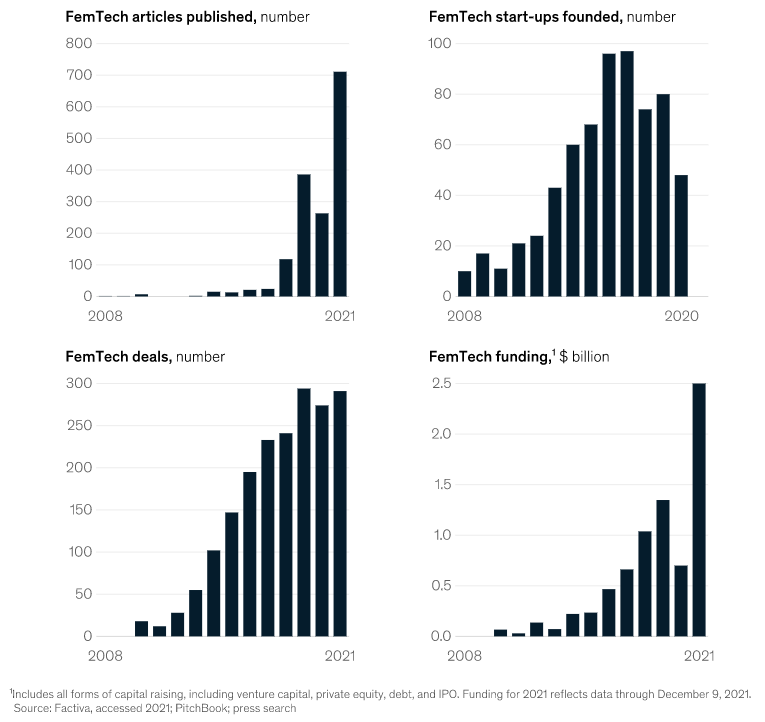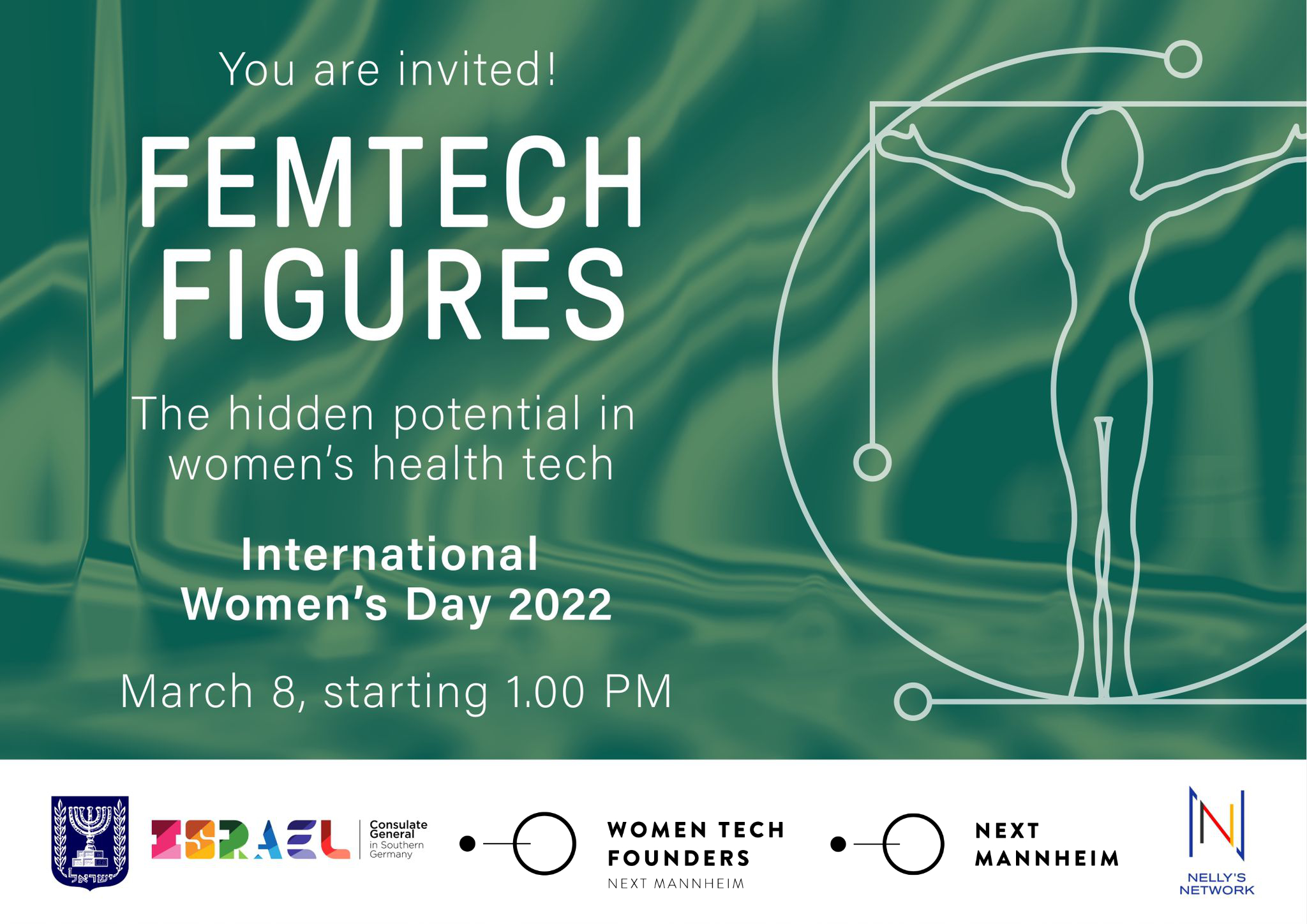What is FemTech?
creating solutions for women's health
What does the term "FemTech" mean?
The FemTech industry, short for Female Health Technology, creates technological solutions targeting women's health. It brings awareness to the historical and systemic exclusion of women's health needs in the healthcare industry, highlights research gaps and empowers women by embracing female bodies in all their facettes.
The targeted healthcare fields range across a number of female-specific areas such as maternal health, menstrual health, pelvic and sexual health, fertility, mental health and menopause, as well as health conditions that affect women disproportionately such as oesteoporosis or cardiovascular diseases.
Why do we need femtech?
Since its beginning the term has received various criticism with the main question being: Why do we need to label these products "female"? After all there is no "MaleTech". By using FemTech, aren't we supporting biases and implying that half the population is a sub-category with body-specific needs?
Hence the inherent critique is that the term contributes to male being the constant, the norm, while female is "the other". It does not ackknowledge other types of gender identification, such as non-binary and might enhance the pink tax. The latter is the finding that products for women are sold at a higher price point due to gender stereotyping in marketing. So why do we need the term FemTech and is its use appropriate?
In short: A distinctive category is needed to show what is left behind. The healthcare industry neglects women's needs and misses out on valuable research and data concerning female bodies. One small example shows how far this goes: Women of child-bearing age were, for many years, excluded from clinical trials for medical treatments to avoid the risk of birth defects and because their hormonal fluctuations were "too complicated" to factor in. More examples of data, research and care gaps are numerous, from the gender pain gap to a 50% higher risk of being misdiagnosed after a heart attack - still only 4% of all healthcare research and development is targeted at women's health issues specifically.
Thus without making the disctintion clear, women's health will continue to not be prioritized, because historically and therefore systemically women have not been a priority in any industry.
As much, as we'd like to, we cannot jump to the end, the main goal, where we are all equal. We need to highlight the areas that currently need attention and support. We need to advocate for women's health now, for it to be understood, respected and dedicated the time, research, resources and visibility it lacks. By pushing this objective we will in turn make the category obsolete.
The rise of an industry
How it all started...
But how did the sector came to be? Here Ida Tin comes into play. She realized how far technology had come in the last decades, but how the science of women's bodies had barely progressed at all. Her company and the idea of the fertility tracking app Clue, were born. She went on to coin the term FemTech in 2016 out of the struggle to discuss female health products with male investors. So she created the category to give those conversations a marketable headline and to bring attention to the industry that lacked funding:
Towards a brighter future?
The underinvestment in FemTech Startups is a complex topic. It stems not only from unconscious gender biases in the investment scene but from cultural taboos and stigmatized perspectives around women's bodies as well as a lack of scope on the broad potential of the presented ideas. A quick example: Menstrual products weren't allowed to be advertised on American television until 1972 and many countries still fail to embrace menstruation as a reality of life.
Many FemTech founders still face ignorance towards the functionality of the female body and the everyday reality of women in pitching rooms. Why? Since only 3,2% of partners in VC's are female they are likely to have to pitch in front of male investors in order to get funded. But the Startup world is slowly changing: "The more we talk about it, the easier it gets. If male investors feel awkward by the mention of 'vagina', argue with numbers and chances", advises investor Tracy Warren. Even if the inherent value of bettering women's healthcare isn't valued enough - its market potential will be.
Ida Tin's Berlin based company is one of the role models that has shown this is possible: It raised nearly 45 Million US Dollar in total, with the latest round in Series C funding being 15 Million in 2020. But that is not a singular case: Overall there has been a steady increase in funding for FemTech startups with predictions of funding in the industry ranging from 3 to 9 billion US Dollar by the end of 2030. In the last years it became clear: The notion of FemTech, innovation of women's health and interest in the topic are on the rise.
a potential worth uncovering
Let's end by highlighting some of the major potentials FemTech startups and innovation in women's healthcare entails...
- Let's start off with what we were touching on earlier: the market potential. Not only is the customer base for FemTech products huge - with up to half of the world's population, it is even bigger, considering that women decide over 85% of all consumer purchases and are often the primary healthcare decision-makers for their families. Hence the target markets are far from a niche!
- FemTech impacts different industries and is a leader for diversity. They push new models of leadership and work, often focus on to date neglected perspectives like PoC in healthcare and more than 70% of FemTech companies in latest analyses had at least one female founder - compared to less than 20% in new startups in general. This opens up the male dominated tech industry for new opportunities for women. Even more: Across the value chain, a more inclusive, gender-aware system could facilitate more women with more diverse backgrounds to become inventors, programmers, investors, health care professionals, scientists and founders.
- FemTech solutions and services are on demand, individualizied and often powered by AI or Machine Learning while also being in an area that needs high trust, personal attention and special service. Hence they are unique in the way they combine High Tech with High Touch leading to new innovations in other fields.
- Last but not least the increased representation leads to more consumer-centric products that recognize and target women’s specific healthcare needs. By putting women's health in focus, families, companies and society as a whole will profit. In the end FemTech products and services are not only achieving commercial success - they are contributing to the conditions for continued innovation and societal growth.
LET'S MEET FEMTECH FOUNDERS!
To explore the potential of FemTech first-hand and get inspired by female founders at the forefront of innovation, check out our upcoming event for Interantional Women's Day: FemTech Figures!




